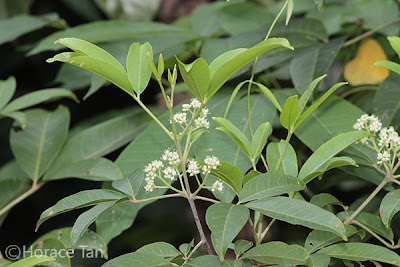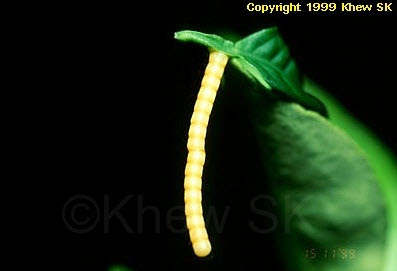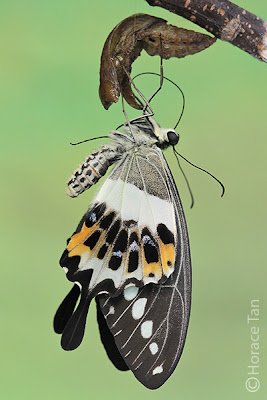The Year In Review

This will be the final weekend feature article for 2012 as we wrap up and close for the year. We look ahead to 2013 with hope and anticipation that our beloved winged jewels will continue to thrive and flourish in our environment on the tiny equatorial island of Singapore. We also look forward to more new discoveries and re-discoveries of species that will be included in the Singapore Checklist of Butterflies.

A Dry-Season Form Bush Brown during the wet season in Singapore?
Throughout the year, this blog recorded a total of 95 articles including this one. A reasonable achievement and an all-time record, considering that in 2011 we did a total of 73 articles which was the highest number of articles since we started this blog. Once again, many thanks to Horace Tan for his meticulous recording of the early stages of Singapore's butterflies, and also to all our members of ButterflyCircle who unselfishly shared their excellent photographs to give that extra quality to the articles on this blog.


Samples of Horace Tan's life history work
Horace recorded a total of 22 excellent Life History articles this year - with the complete photographic record of each species' from egg to all caterpillar instars to pupa. In many cases, video recordings of pupation and eclosion are also captured in vivid detail! There are few, if any, comparable work that records the butterflies' early stages with such meticulousness and detail.

Indeed, it was Horace's efforts that yielded ButterflyCircle's second book on the Caterpillars of Singapore's Butterflies. This book, published by the National Parks Board, was launched successfully on 26 May 2012. It was the culmination of many months of hard work by the NParks team (Rachel, Li-San and Linda), Horace and myself to put the book together from design, content, proof-reading and the final printing. It was indeed a satisfying project for all involved and the effort paid off when we saw the final product. It was an achievement for ButterflyCircle to have contributed to nature education and sharing of knowledge with specific reference to Singapore's butterflies.

A collage of ButterflyCircle members at the Festival of Biodiversity
Also in 2012, ButterflyCircle was featured at the Festival of Biodiversity. The Festival was jointly organised by the National Parks Board and the Biodiversity Roundtable as a platform to showcase the nature community's efforts and raise awareness of Singapore's biodiversity. We are proud to have been featured as a standalone community of butterfly enthusiasts and given recognition for the work that ButterflyCircle has done to promote the conservation of butterflies in Singapore.


Tampines-Changkat Butterfly Garden and Nature Centre featured in a media report
ButterflyCircle members also contributed to the creation of a Butterfly Garden at Tampines-Changkat. The brainchild of Member of Parliament Ms Irene Ng, the Butterfly Garden was set up by a community group that has seen the Butterfly Garden featured in many publications and media articles. Following the success of the Butterfly Garden, the new Tampines-Changkat Nature Centre was set up and declared open on 1 Sep 2012 by Ms Irene Ng. This Nature Centre functions as an education resource for nature enthusiasts and a meeting place for like-minded volunteers in Tampines-Changkat. More plans are in store for 2013!

Our four new butterfly species discoveries in 2012
A total of four new butterfly species were discovered in the year. These were the Common Jester, Plain Puffin, Banded LineBlue and the Yellow Flat. Three of the species were discovered by ButterflyCircle member Federick Ho (he must be extra lucky this year to have the Butterfly Fairy smile on him three times!). By a "discovery" we mean that the species has not previously been recorded before by the early authors, collectors and researchers. All four species can be found in Malaysia, but have never been listed on any Singapore checklist before.
There are several other species pending confirmation or further validation, so we will leave those for 2013 or when the species are confirmed with a good level of certainty by experts. Most of these unconfirmed species belong to the families of Lycaenidae and Hesperiidae, of which there are many lookalikes that may give some element of doubt without careful validation.
RANDOM GALLERY SERIES BY BUTTERFLYCIRCLE MEMBERS

In March 2012, this blog also started a Random Butterfly Gallery series that showcases the excellent photography of ButterflyCircle's members. The series adds more colour and frequency to the blog articles in between the longer and more detailed weekly feature and life history articles.


Favourite Butterfly Nectaring Plants series
In June 2012, we also commenced a new series on Favourite Butterfly Nectaring Plants, starting with the Snakeweed which was followed by the StringBush. More plants will be added in future articles and the information will be useful for those who are planning on setting up their own little butterfly garden or just planting to attract butterflies.

In July 2012, ButterflyCircle also played host to US researcher Melissa Whitaker who is pursuing her Doctorate at the University of California, Davis. Her subject matter involves the study of butterly-ant relationships or myrmecophily. Melissa was on a tour of SouthEast Asian countries to collect material for her research when she dropped by Singapore for a couple of days to learn more about our local butterfly fauna.

ButterflyCircle and the Caterpillars of Singapore's Butterflies were also featured in NParks online newsletter, My Green Space. The prolific fellow-blogger, Dr Wee Yeow Chin of the Bird Ecology Study Group (BESG) also chipped in and shared his stories of breeding the Atlas Moth (Attacus atlas). I have always admired Dr Wee for his hard work and sharing of articles of interest about birds, and has contributed more, in terms of educating nature enthusiasts and the layman alike, than any other birder has done.
BUTTERFLIES OF THE MONTH FROM JAN - DEC 2012

The five-year running series, Butterfly of the Month, saw the continuation of the long-running feature articles showcasing our beautiful flying jewels with 12 more species featured in each month of 2012. Which one is your personal favourite Butterfly of the Month in 2012? Do post a message on this blog and let us know.



Exotic butterfles from Sulawesi and Taiwan
ButterflyCircle members also organised group outings beyond Singapore's shores to learn more about butterflies in the region. Trip reports and mouth-watering butterfly photos from various locations in Thailand, Sulawesi, Hong Kong, Taiwan and Malaysia can be found at our forums.
A Butterflies of Singapore FaceBook Group was also set up, and the active site has daily posts from members from all over the world. The membership is growing steadily and at the time of this article, has already gone past 460 members.

All in all, it has been a very eventful year for ButterflyCircle. We hope to continue by sharing our members' works and stories in 2013 and for as long as we can. It is encouraging that besides the founding senior members and stalwarts in ButterflyCircle, we also have young and talented members who have joined us as well.
We would like to take this opportunity to wish all our members and readers of this blog a HAPPY NEW YEAR!
Text by Khew SK : Photos by James Chia, Sunny Chir, Chng CK, Federick Ho, Goh Eng Chuan, Huang CJ, Khew SK, Koh CH, Loke PF, Nelson Ong, Jonathan Soong, Horace Tan, Tan CP, Lemon Tea, Anthony Wong & Benjamin Yam
You have read this article with the title 2012. You can bookmark this page URL http://butterflymuse.blogspot.com/2012/12/2012-year-in-review.html. Thanks!























































